
 |
Eager Space | Videos by Alpha | Videos by Date | All Video Text | Support | Community | About |
|---|

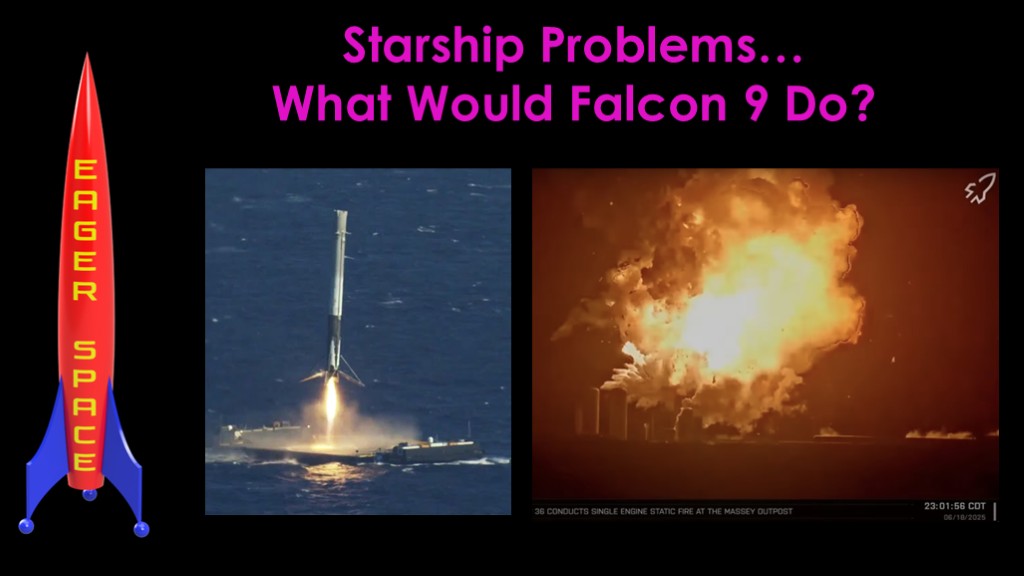
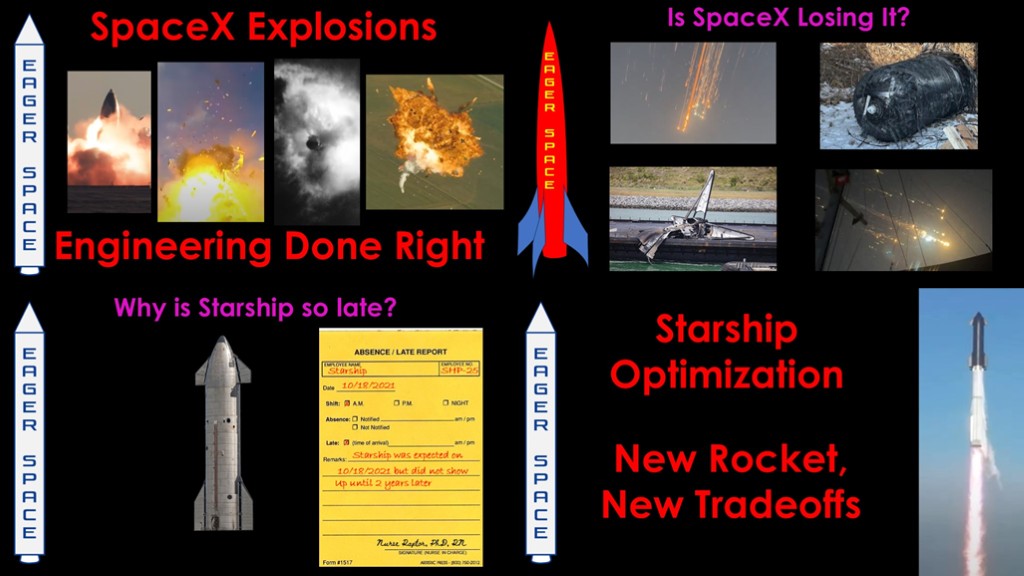
I've done quite a few videos on starship, and one of the hard parts has been figuring out how to evaluate the program.
Starship is trying to do something that has never been done before - reuse both the first and second stages of a rocket - and they're trying a development approach that has never been tried before, and that makes it challenging to come to any meaningful conclusion.
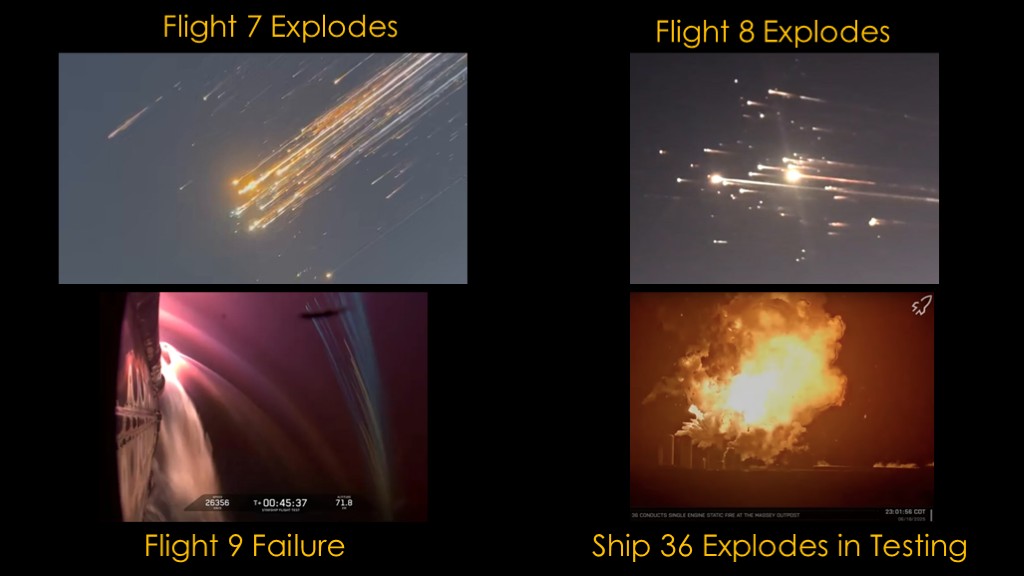
But starship 2 challenged my viewpoint. Flight 7, ship explodes on boost. Flight 8, same. Flight 9, ship gets into orbit but goes out of control.
And now ship 36 explodes during testing and damages the test site.
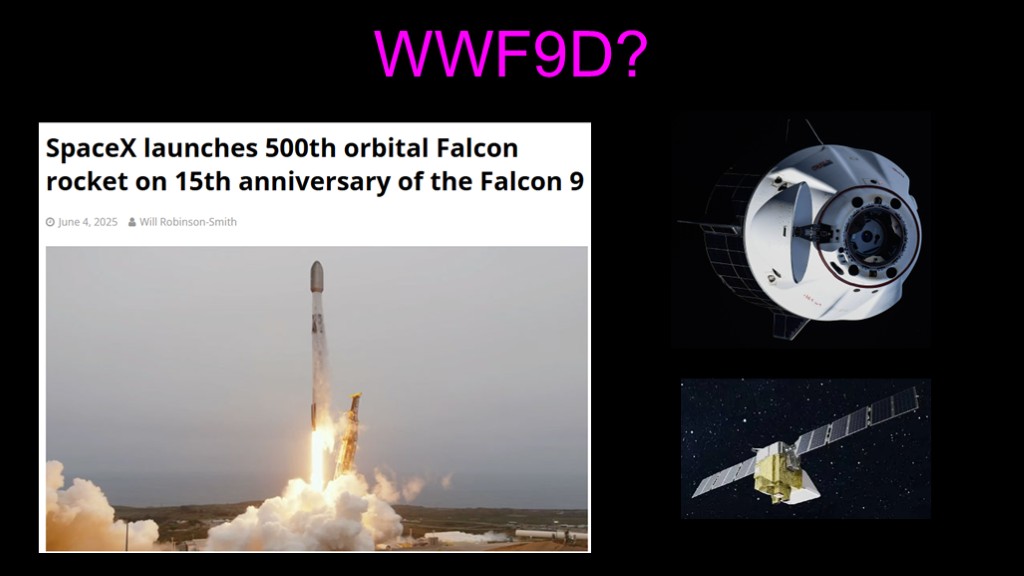
I had an idea recently on how this might be done.
SpaceX's reputation is based on three programs.
The first is obviously Falcon 9, an expendable medium launch vehicle built to take supplies to the international space station and then upgraded multiple times and modified to make the first stage reusable. It might be the most impressive launch vehicle ever, certainly the most impressive one created by a commercial company.
Along with Falcon 9 we got Dragon, first in cargo form, and then as dragon 2 carrying both cargo and astronauts to the international space station.
And the third is Starlink, an idea that seemed fanciful at the outset until you realized that SpaceX was actually serious about launching thousands of satellites.
The exceptional part of this is the apparent ease doing it, and how quickly first stage landing and reuse went from impossible to mundane.
My new benchmark is based on the extremely successful approach used by these programs. The question it asks is "how would the Falcon 9 team have approached the project and what could we have expected them to do when specific things happened?"
Or, more simply, what would Falcon 9 do?
Before we dig into Starship, I need to talk about why the Falcon 9 team was so exceptional.
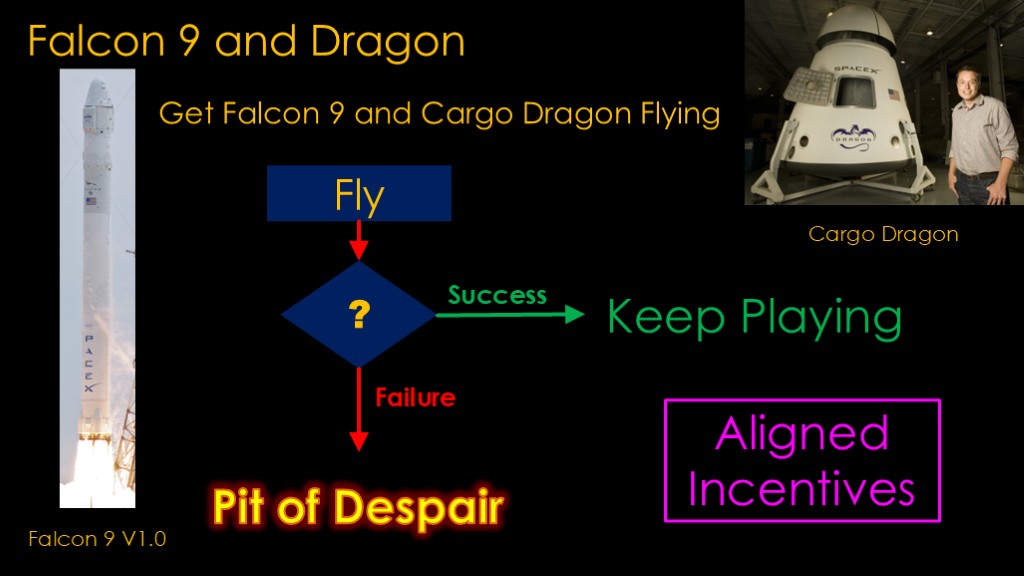
From 2005 to 2010, the world of SpaceX was very simple.
Their task was to get Falcon 9 and Cargo Dragon flying to meet the terms of the NASA contract.
You fly a vehicle, and if it works, you get to keep playing the game and perhaps - over time - get to work on even cooler things.
Fail, and you end up in the pit of despair. Everybody loses their jobs and need to find a new job with a recent failure on their resume. It's a simple world because the incentives of everybody are aligned. Success is good for everybody in the company, including the Founder.

In startups there is significant urgency because there is both a lack of money and a lack of time.
SpaceX needed to hit the NASA contract milestones to get paid and start flying missions for NASA so that they could sell launches to commercial customers. If they want to survive and prosper, they need excellence in execution.
There's a claim that the SpaceX philosophy is "Move Fast and Break Things", but that's very clearly *not* the philosophy of the Falcon 9 team.
Falcon 9 version 1.0 flew 5 times across 3 years. All of them completed what they needed to do with Dragon, and flights 3, 4, and 5 delivered supplies to the International Space Station.
SpaceX was on the edge during this entire period, and any significant failures could have led to the failure of the company. Failures during Falcon 1 very nearly did led to failure, and everybody working on Falcon 9 knew it.
The only issue on those first 5 flights was a booster engine shutdown in flight 4 which put them in a lower orbit than planned and NASA rules prevented them from restarting the second stage to put their secondary payload in the proper orbit.
These are ridiculously good results for a small young team building not only a new rocket but a new capsule.
I don't know if the Falcon 9 team has a motto, but I'd choose something like: "Fast, Cheap, and Do It Right".
And it is the founder's job to keep the team on track, a job that Musk did very well.
The Falcon 9, Dragon, and Starlink teams would carry that mindset until the current day.
Time to look at starship...
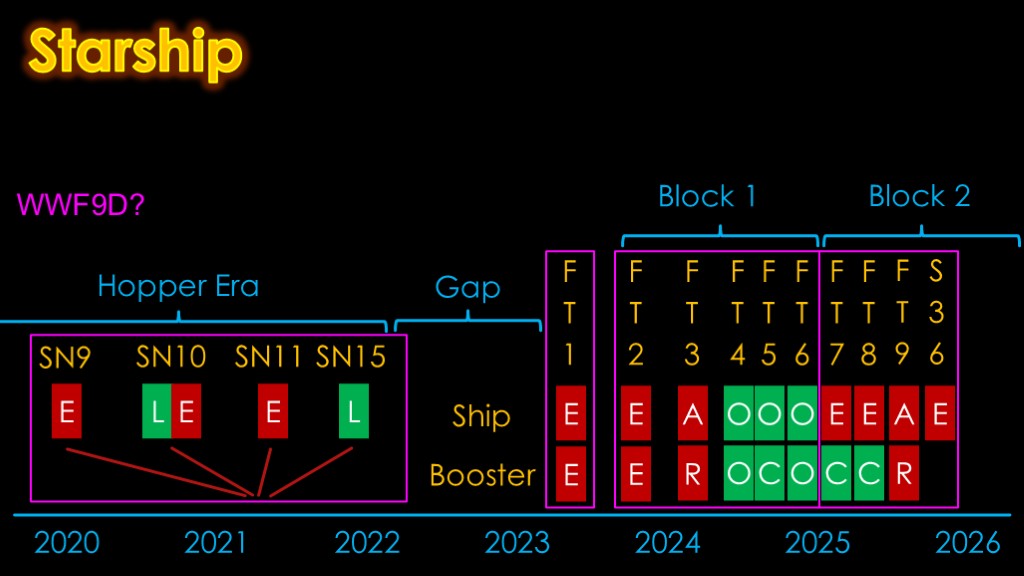
Let's move on to Starship
We'll start in the hopper era, skipping the early tests. In this era, SpaceX was working on the landing portion of Starship, trying to develop a vehicle that could descend horizontally and flip and land vertically at the last second. Another thing that had never been done.
SN9 crashed into the ground and exploded. SN10 surprised us by landing intact, and then surprised us again by exploding after landing.
SN11 had engine issues and crashed into the ground. And finally, SN15 landed intact and became the last hopper.
All that happened in a very short 4-month period.
What would Falcon 9 have done? Well, as far as I can tell, the development during this time period was pretty much run by previous members of the Falcon 9 team, so I think this is exactly what they would have done. All the easy stuff worked, and they went from explosions on landing to success in 4 short months.
Great performance.
We now enter an extended time period without any flights. There are different theories as to what the cause of this gap was; I think it was at least partly related to raptor availability.
Then we got flight test 1, the first time the full Starship/Super Heavy stack would be assembled and launched.
The only word I can use to describe the launch is "fiasco"; the launch pad area was heavily damanged, multiple engines failed, the vehicle didn't stage, and it couldn't even blow itself up properly.
What would F9 have done? It's pretty clear that they would never have flown a vehicle in that situation - there was pretty much zero chance that it would achieve what they were hoping to achieve.
We can see a significant change in the company attitude at this point; both Musk and Shotwell stated that the goal of the flight was not to blow up the launch pad. It would be an understatement to say that I was disappointed.
This was the point where I started experiencing cognitive dissonance, and my rationalization was that since SpaceX was a very talented team, this was just an indication of how hard their task was. But looking back I realize that this was a very public demonstration that the Starship team was not like the Falcon 9 team.
We now move onto the block 1 starship era.
Flight test 2 was much improved; the engines worked, they got through hot stage separation, but after the booster flip engines shut down and the booster exploded. The ship had a complex failure that led to shutdown and flight termination. The booster issues weren't unexpected, but the ship failure was disappointing.
Flight test 3 got both vehicles into the proper location. The booster was destroyed near landing, and the ship lost attitude control in orbit and burned up on reentry.
Flight test 4 was the first big success. The booster survived reentry and did an ocean landing, and ship somehow survived significant damage during reentry and also landed successfully.
Flight test 5 was another step forward. The booster was caught at the launch tower, and Starship reentered and landed where it was supposed to.
Flight test 6 was nearly a repeat of flight 5, though the booster catch was not attempted due to damage to the catch tower during liftoff.
That takes us to the end of the Block 1 starship era. What would F9 do? Flight 2 was a lot better, but was maybe not as ready as it could be. Flight 3, 4, 5, and 6 were in the spirit of Falcon 9 development. Things were looking up.
And finally, we get to block 2, where the wheels started to come off.
The booster performance was mostly fine, with two successful catches. The flight 9 booster was one that had been caught before and flew an "envelope expansion" trajectory that was more challenging, and did not survive reentry. That's not a huge disappointment, but Falcon 9 boosters had flown more aggressive profiles a number of times and they were all successful.
The block 2 ship exploded on boost twice in a row and then went out of control before reentry on the third flight.
Then ship 36 blew up during testing.
This is such a weird pattern. Out of 8 flights, Starship has blown up during boost on 3 of them, lost control after boost in two of them, and made it through reentry 3 times with various levels of success. They have failed on what is supposed to be the easy stuff over 60% of the time and succeeded at the hard stuff all three times they could attempt it.
What would F9 have done? The simple answer is that the Falcon 9 team would have built a vehicle that didn't have these issues, because they would have made sure it didn't have those issues. And if they had unexpected issues, they would have stopped until they had them fixed.
The block 2 vehicle is clearly not ready to be flying, and from the outside it's not clear what the exact cause is.
What is going on? How did a program that started so well end up in this state?
I have three contributing factors to talk about, and after that I'll talk about the future.
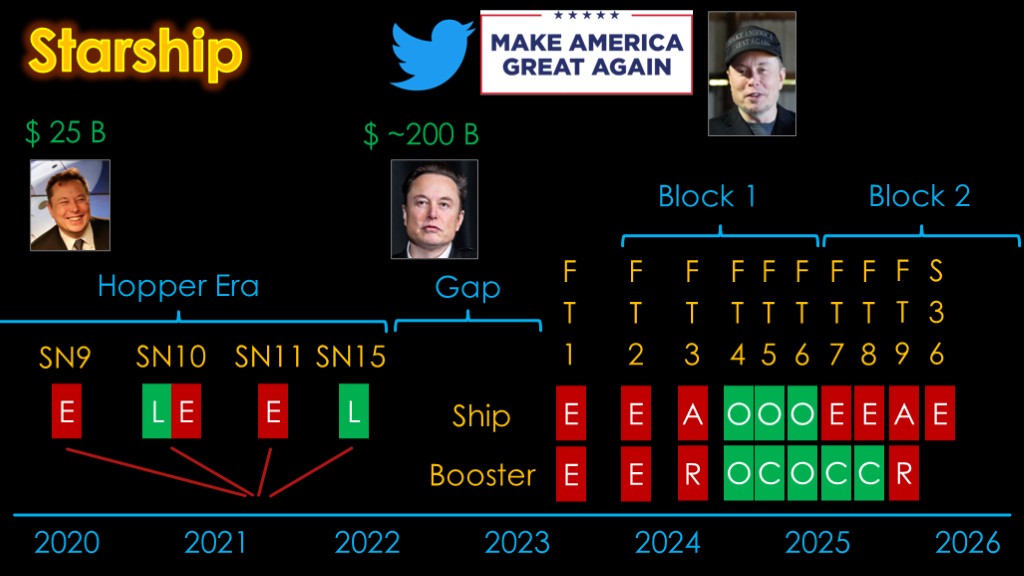
I'm going to start by talking about the elephant in the room, or in this case, the elephant that was not in the room.
Back in 2020, Musk was a very rich man with a new worth of about $25 billion, but two years later that number had soared to around $200 billion - sometimes more, sometimes less, depending on the value of Tesla stock.
Musk decided he wanted to buy twitter, decided he wanted not to buy it, then decided to buy it again. He wasn't paying the same amount of attention to SpaceX or Tesla. Soon after, he decided to join the make America great again group and campaign for trump.
This is a huge issue. Musk had been the prime decision maker in the past, but with him not around, decisions still had to be made. Were they made the way they would have been made for Falcon 9? The answer is pretty clearly "no".
The pattern is clear. In the hopper era, things went about a well as could be expected. During block 1, they went okay but not great. And in block 2 they have gone horribly wrong.
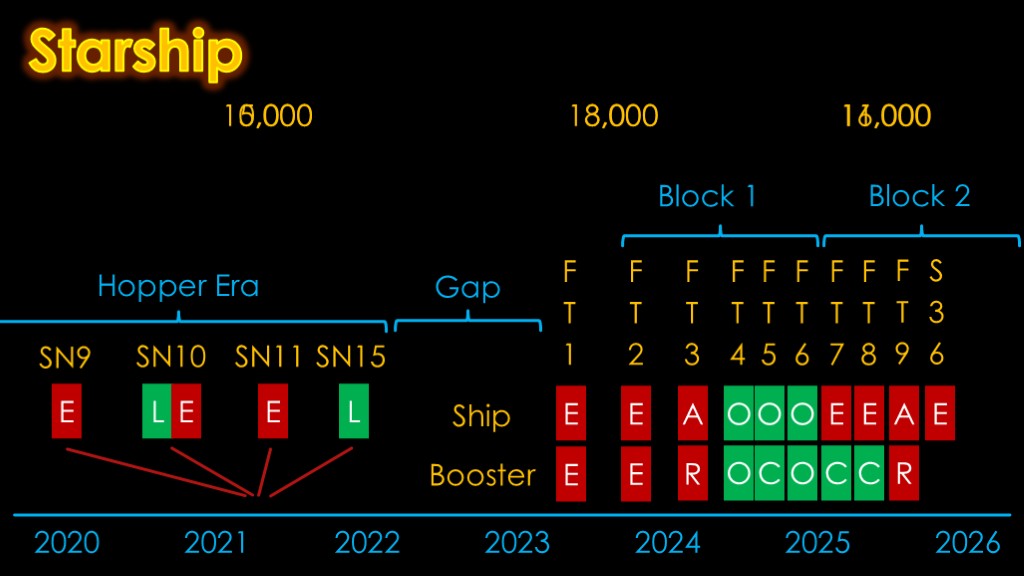
The second issue is team size.
SpaceX doesn't regularly publish employee numbers, but we do have reported numbers of 10,000 in 2021, 13,000 in late 2024, and 16,000 in 2025. That is company-wide, but my guess is that most of the growth is in starship, so we might estimate 5000, 8000, and 11000 dedicated to starship. That is more than double in 5 years, and the big growth likely came earlier.
It's challenging for any company to grow that fast and preserve their culture, doubly hard when there's a vacancy at the top.
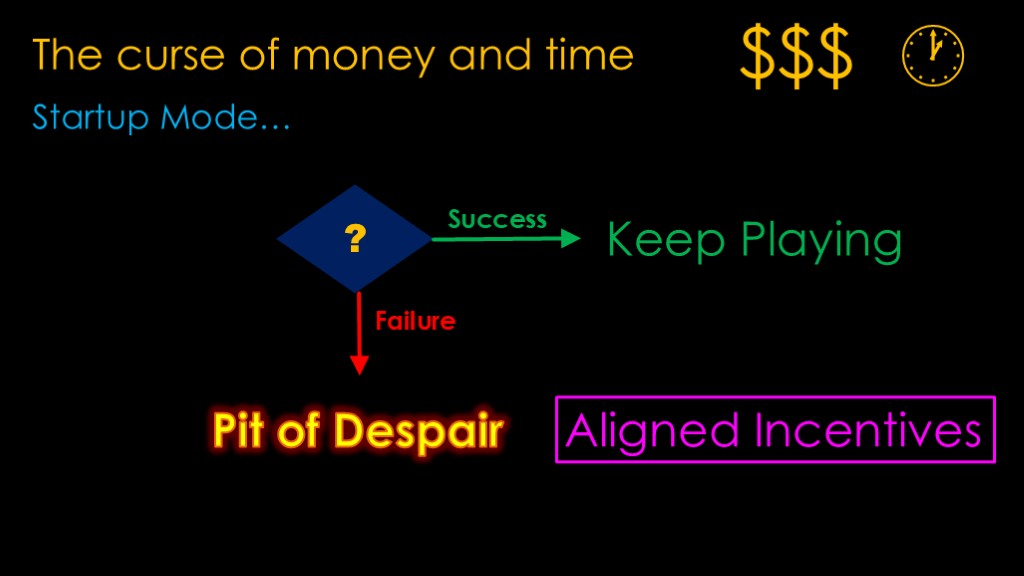
A third issue is a syndrome I call the curse of money and time...
In startup mode, being successful is critical to the success of the company and everybody is working towards the same goal. That was the environment that spawned Falcon 9 and Dragon and continued into Starlink.
When you have money and time, thing tend to change.
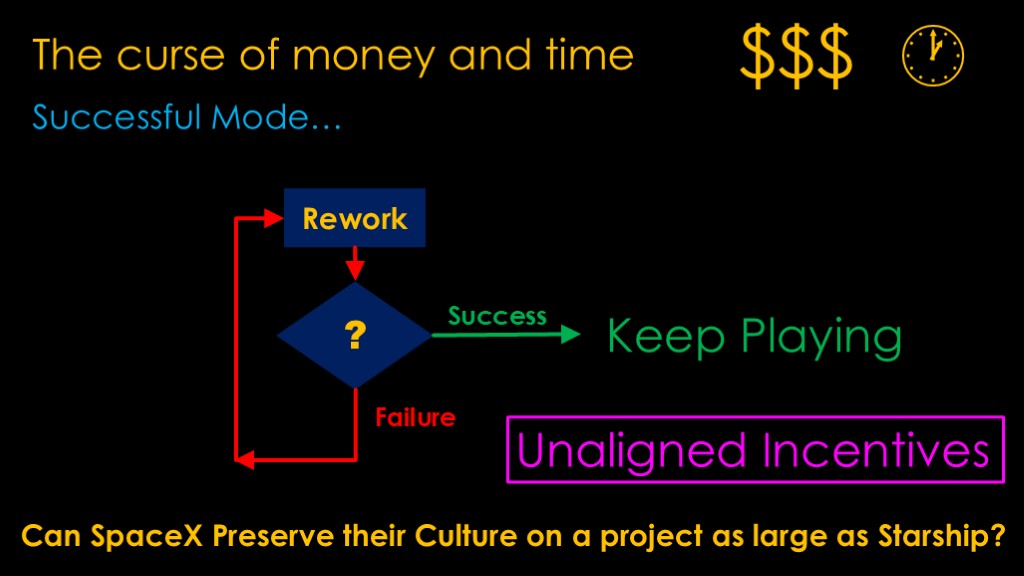
Once a degree of success has been achieved, the sense of urgency dissipates. Failures or being slow no longer have the same impact - you just rework and fly again. It's very easy to spend 6 months and find yourself no close to your goal.
A bigger problem is unaligned incentives. The individual contributors are still working on the project, though they often lack the focus that existed in startup mode. But worse, management starts becoming more concerned about their careers than about the success of the project or company. This is bad enough in general, but worse when the company is growing very fast.
This is why software companies get bigger by purchasing startup companies rather than doing the cool new thing themselves. Management is playing the career game and it's really, really hard to operate like a startup in a big company.
*Way* back when starship was announced, I had a thought.
My thought was, "Can SpaceX preserve their culture on a project as large as starship?"
I then promptly forgot that thought until I was writing this video.
My answer right now is "no", they have not been able to create that same culture in Starship.
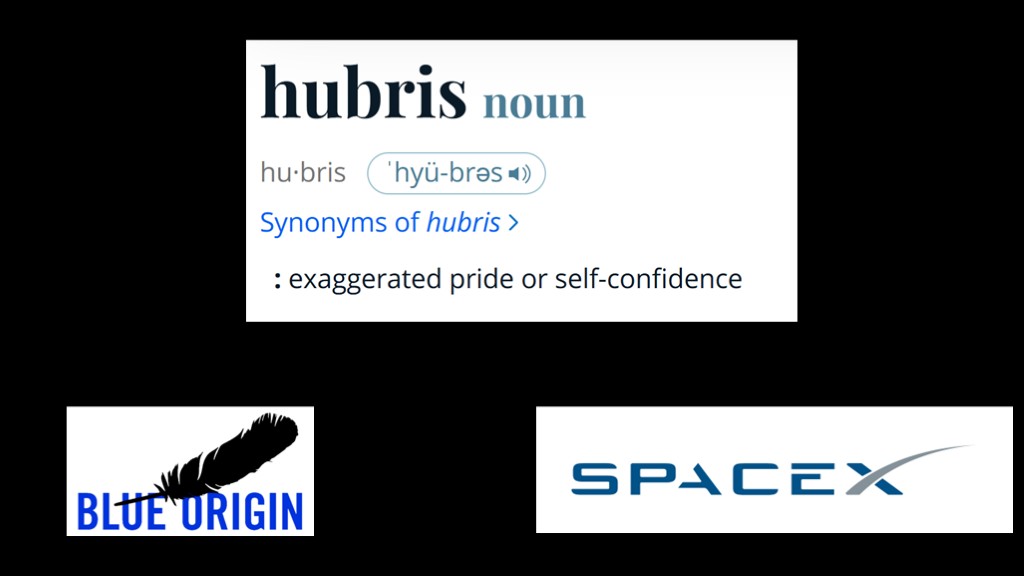
And there's a bonus problem and that is Hubris.
SpaceX has been an extremely successful company because the quality of their work was so great and they were quicker and cheaper than everybody else. They have been the irresistible force.
But that's clearly not the case right now. There are too many cowboys who are fine with blowing things up and not enough people working effectively towards the end goal. Starship is a sloppy program.
I used to make the joke that if you looked up hubris in the dictionary, there was a link to Blue Origin, but sad to say, it now applies to SpaceX.

So the big question is "how to fix it"?
It turns out that there is another historical situation that was similar to this one.
Any guesses?
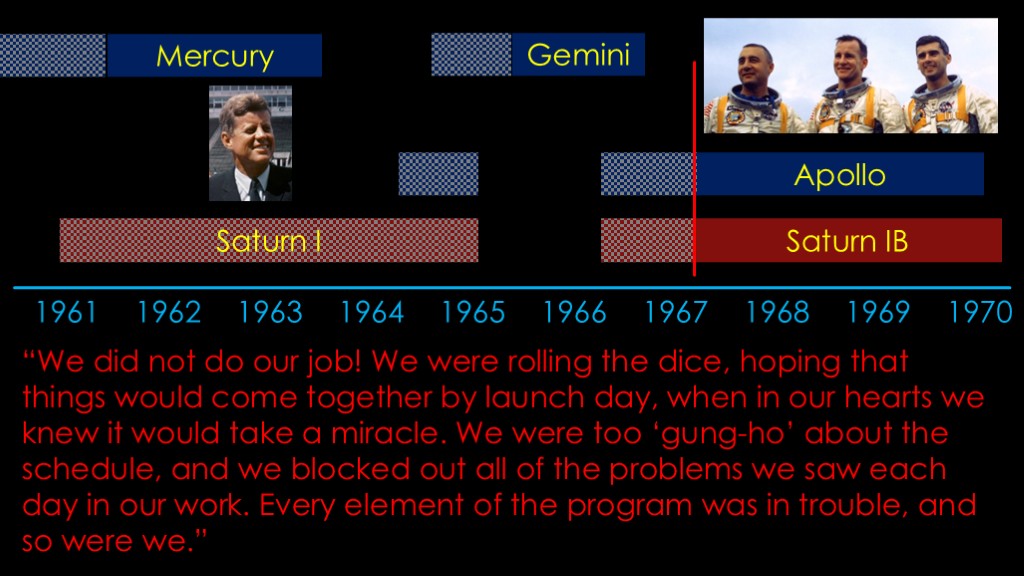
It happened during NASA's human spaceflight program.
NASA Mercury program was progressing along with uncrewed test flights followed by crewed flights. After 4 flights, NASA got new marching orders - President Kennedy told NASA that their goal was to get to the moon by the end of the decade.
NASA shifted into high gear, and in a well-funded environment they tried to move as fast as possible.
Sound familiar?
Some testing of the Apollo command and service module could be done with the Saturn I rocket, but there was going to be a big gap before the Saturn IB rocket was ready to carry astronauts.
Project Gemini was added to fill in the time between Mercury and Apollo and to learn as much as possible. They flew 2 uncrewed flights in a little under a year and then flew 11 crewed flights in only 22 months. That was hugely impressive performance.
Two block 1 versions of the command and service module were planned to fly on the Saturn IB in 1966, and then the first crewed flight would be in early 1967.
There were lots of issues across the organization - the Lunar Module was late and overweight - and there were big issues between NASA and North American, the contractor on the Apollo Command and Service module. But NASA pressed on.
And then on January 27, 1967, fire broke out in the Apollo 1 capsule and killed Astronauts Gus Grissom, Edward White, and Roger Chaffee.
Three days after the tragedy, Flight Director Gene Krantz told his team the following:
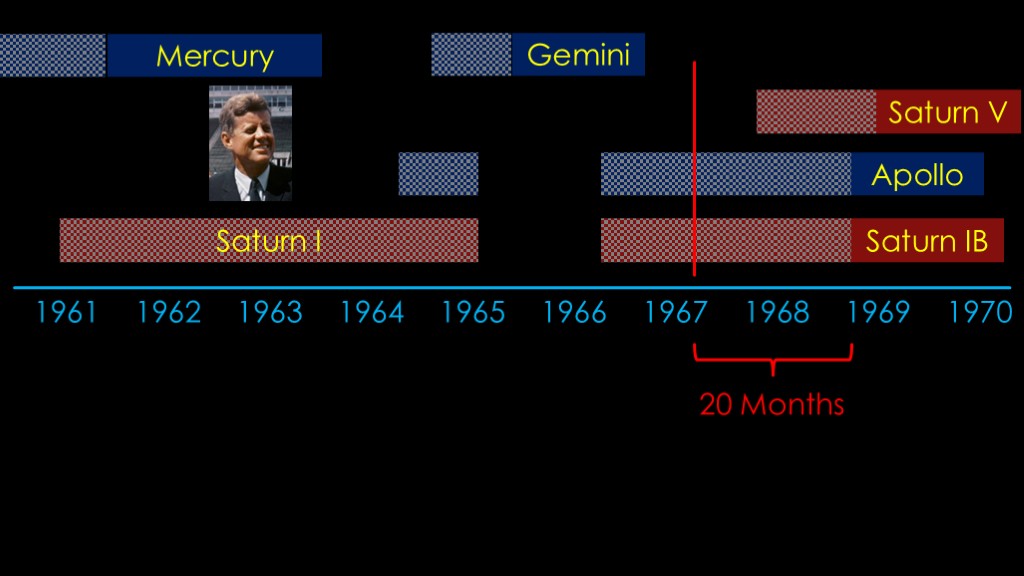
The Apollo team took a step back and went over everything in the program. They decided to wait for the improved block II command and service module, and they didn't fly crew for 20 months, with the first flight in October of 1968.
Then they flew Apollo 7 through Apollo 11 - 5 flights - in the next 9 months and achieved the goal that Kennedy had given them 7 years earlier.
Apollo 1 was a tragedy, but the 20 month pause that followed it was critically important to the Apollo program, and in my opinion, NASA would not have gotten to the moon by the end of the decade without it.
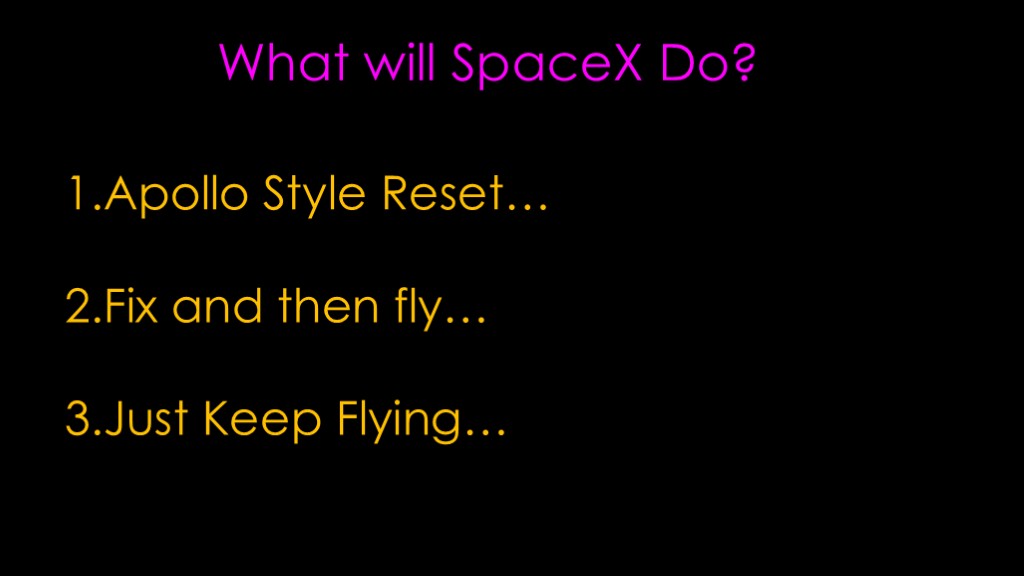
What will SpaceX Do?
I see three broad options...
They could do an Apollo style reset, invest a few months digging into all the issues, figuring out the root issues that they are seeing and other issues they may have been missing, and fix them.
I would characterize this as a "Stop being sloppy and spend the right amount of time up front" approach.
They could target the specific issues they've had - engines and tankage in starship - and do deeper investigation of those issues. That's a "fix the visible problems and then fly".
And there's the "Just Keep Flying" approach. We're SpaceX, we'll figure it out.
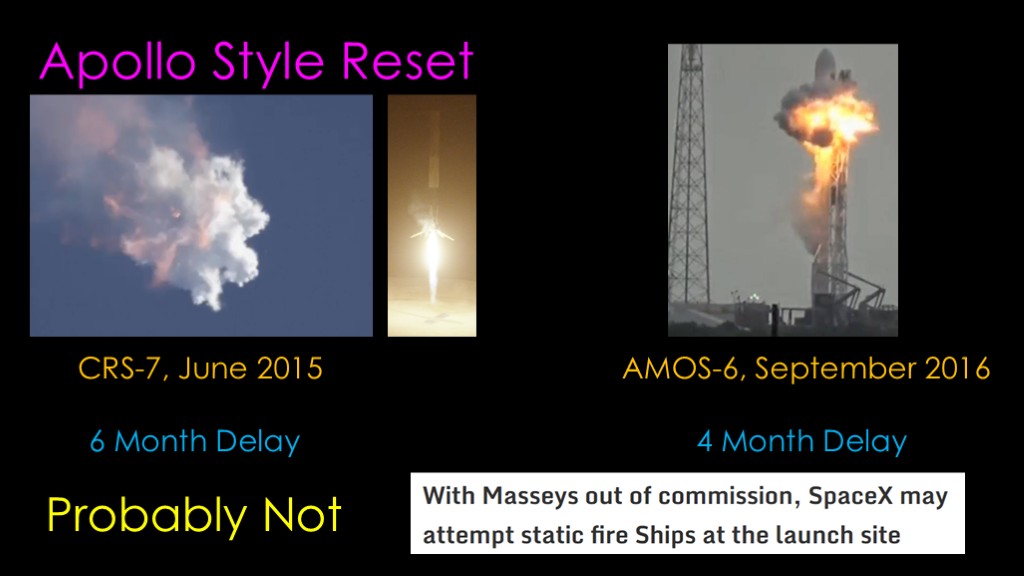
Let's look at the Apollo reset scenario...
Falcon 9 had a couple of failures where they used that approach.
The first was the CRS-7 dragon resupply mission in June of 2015, where a broken strut on a helium tank led to an overpressure event on the second stage. That resulted in a 6 month delay for Falcon 9.
It also resulted in a 6 month delay for the reuse program, and the first successful landing was on the next flight. Could be a coincidence, could be that the delay allowed the reuse folks to step back and analyze their program as well.
The next year there was the Amos 6 explosion during propellant loading before a static fire test. It was also an issue related to the helium pressurization tanks. This one resulted in a 4 month delay.
Will SpaceX choose this option?
Probably not.
The right time to do it would have been after the consecutive failures of FT8 and FT9, and they obviously chose not to. Or now, after another failure and the failure during testing.
There are reports that they might restructure the launch site so that static fires of the ship could be done at the launch pad, avoiding a long delay.
I think the current state is more of a forced delay, not a delay to fix the program.
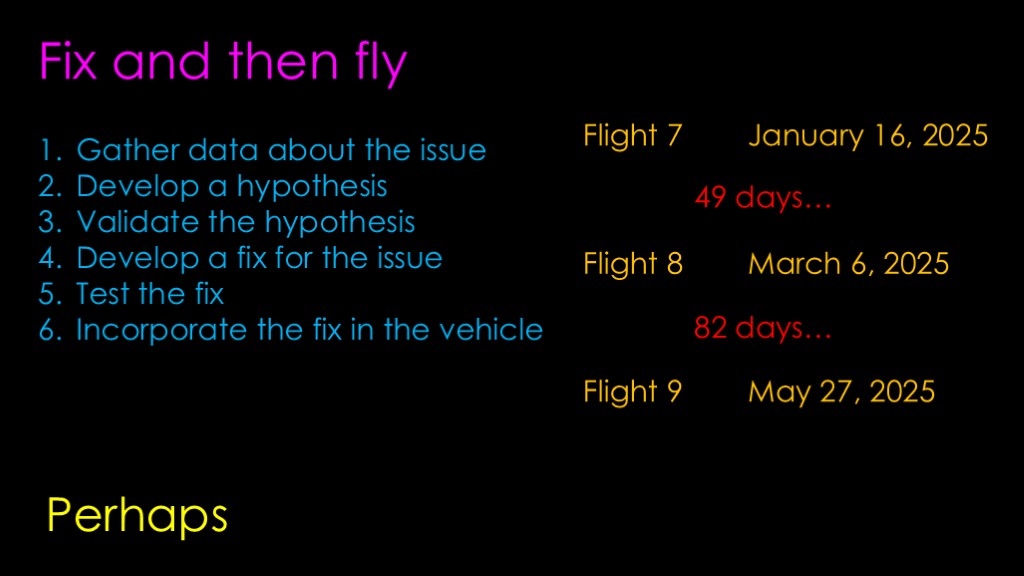
What about investigation of specific issues, fixing them, and flying when the fix is clearly proven?
It looks like they are doing this, but the process is complicated.
(read)
The delay between flight 7 and 8 was 49 days. I think this is enough time to come up with *a* fix, but it's not clear that it's enough time to come up with *the* fix.
The delay between flight 8 and flight 9 was 82 days - nearly double the time - and that provided a lot more time to go through the process. It was apparently successful but despite the longer time there was another issue that they didn't find.
But that flight in may was only 5 days after the FAA said that SpaceX could return to flight, so the longer delay may have been due to the accident investigation.
I'm not convinced that the next flight is driven by a complete fix for an issue rather than by the FAA timelines and manufacturing delays, so I'll say "perhaps" to this one.
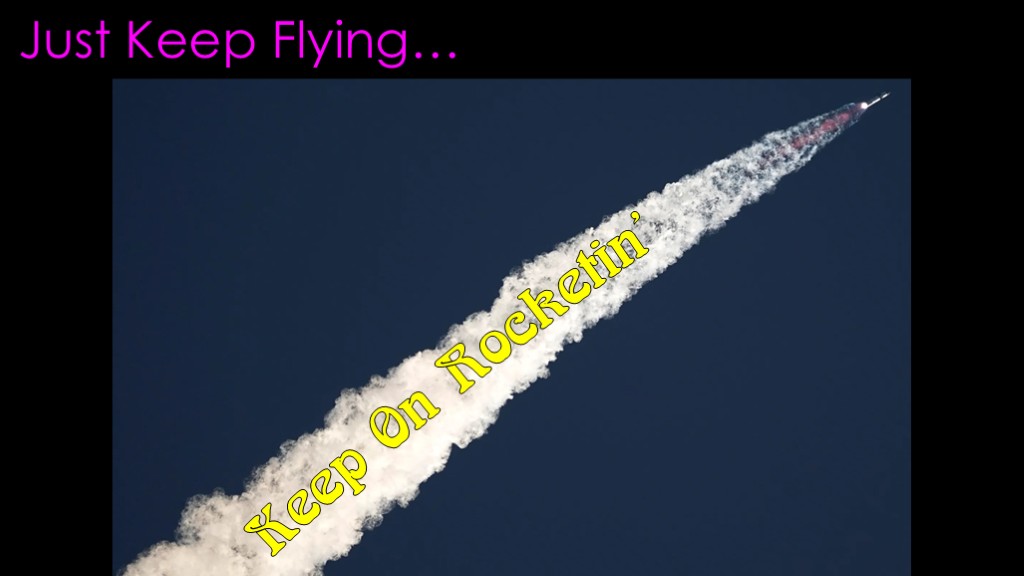
Which brings us to the final option.
That approach was mostly successful for block 1, but the block 1 design was years in the making, benefited from the gap after the hopper flights, and most of the flights had 3-4 months between them.
Block 2 could build on block 1 but the design had much less time to finalize and there was only a two month gap from the last block 1 flight and the first block 2 flight.
I don't think this is an optimal strategy but it seems to be the one SpaceX is going to use, at least for now.
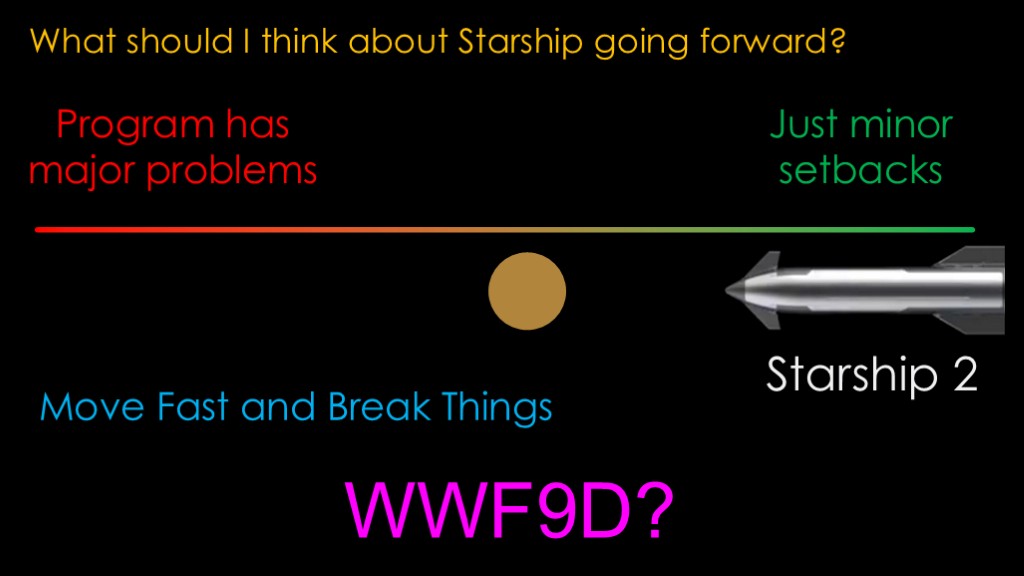
What does this mean?
I used to be here in the middle, because it's a really hard program to evaluate. Nobody has every tried to build a rocket in this sort of hardware rich environment. It's certainly going to take more hardware, more flights, and probably more money than a Falcon 9 - like approach, but the starship approach might yield a more optimal result and it might end up being faster.
But starship block 2 has broken me.
At this point block 2 is a failure, and it's not even a close thing. It's failing at rocket 101 - getting into the target trajectory and getting on with the mission. They have succeeded at moving fast and breaking things, but that's all that they've done.
What would Falcon 9 do?
First, they worked very hard to never get into this sort of situation and have succeeded across 500 launches. But if they did find themselves here, they would be very, very embarrassed.

If you enjoyed this video, here's your song of the day...
https://www.youtube.com/watch?v=2Py37G9qsfY